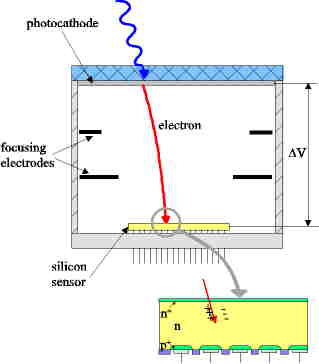A Hybrid Photo Diode (HPD), somtimes also called Hybrid Photo Detector, is a high sensitivity photodetector which allows to detect extremely low light levels, even single photons.
As shown on the schematics on the right, a HPD consists of a vacuum tube, capped with a transparent front window. A photocathode is deposited by vacuum evaporation onto the inner side of this window. Following the absorption of a photon, an electron may be emitted from the photocathode. The probability of this process is defined as quantum efficiency.
What has happened so far, is absolutely identical to a conventional photomultiplier tube. The main feature of a HPD is the mechanism by which the gain is achieved, i.e. how is this single photoelectron multiplied such that a detectable number of electrons is produced.

Schematic drawing of a HPD